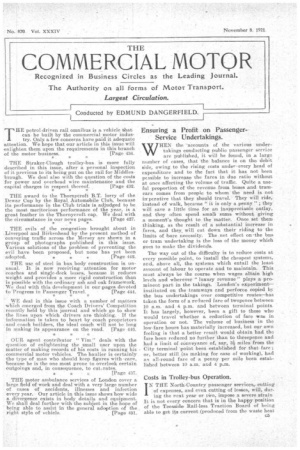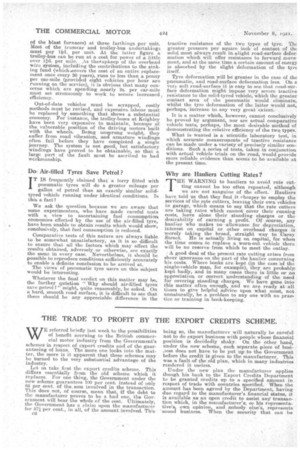Ensuring a Profit on PassengerService Undertakings.
Page 1

Page 2

If you've noticed an error in this article please click here to report it so we can fix it.
HEN the 'accounts of the various undertakings conducting public, passenger service are published, it will be found, in a large number of cases, that the balance is on the debit side., owing to the rising costs under-every head of expenditure and to the fact that it has not been pcssible to increase the fares in due ratio without at once affecting the volume of traffic. Quite a useful proportion of the revenue from buses and tramcars comes from people to whom the need is riot ircperative that they should travel. They will ride, instead of walk, because " it is only a penny " ; they will save a little time for an inapprecianle outlay, and they often. spend emali sums without giving a moment's thought to the matter. Once set them thinking, as the result of a substantial increase in fares, and they will cut down their riding to the limits of bare necessity. The net effect on -the bus or tram undertaking is the loss of the money which goes to make the dividends.
The way out of the difficulty is to reduce costs at every possible point, to install the cheapest systems, and, above all, the systems which entail the least amount of. labour to operate and to maintain. This must always be the course when wages attain high levels and wherever " luxury revenue" plays a prominent part in the takings. London's experiment— instituted on the tramways and perforce copied by the bus undertakings over competitive routes–has taken the form of a reduced fare of twopence between 10 a.m. and 4 p.m. and between terminal points. It has largely, however, been a gift to those who would travel whether a reduction of fare was in operation or not. The volume of business in the low-fare hours has materially increased, but our own feeling is that a better result would obtain had the fare been reduced no further than to threepence and had a limit of conveyance of, say, 31 miles from the City terminal •point been established for that fare ; or, better stilt (as making for ease of working); had an all-round fare of a penny per mile been established between 10 a.m. and 4 p.m.
Costs in Trolley-bus Operation.
IN THE North-Country passenger services,cutting of expenses, and even cutting of losses, will, during the next year or tWo, impose a severe strain It is not every concern that is in the happy position of the Teesside Rail-less Traction Board of being
able to get its current (produced from the waste heat
of the bleat furnaces) at three farthings per unit. Most of the tramcar and trolley-bus undertakings must pay lid. per unit. At the latter figure a trolley-bus can be run at a cost for power of a little over lid. per mile. As thetupkeep of the overhead Wire system, including the contributions to the sinking fund (which•covere the cost of an entire replacement once every 20 years), runs to less than a penny per car-mile (provided eight vehicles per hour are running on the service), it is obvious that many concerns which are spending nearly 2e. per car-mile must set strenuously to work to secure increased, efficiency.
Out-of-date vehicles must be scrapped, costly methods must be revised, and expensive labour must be replaced by something that shows a substantial economy. For instance, the trolley-buses at licighley have been very expensive to maintain, becauise of the vulnerable position of the driving motors built with the wheels. Rettig unsprung weight, they 'suffer from road vibration, and armature windings often fail before they have completed a single journey. The system is not good, but satisfactory windings have proved to be obtainable so that a largo part of the fault must be ascribed to bad werkmanship.
Doi Air-filled Tyres Save Petrol ?
IT IS frequently claimed that: a lorry fitted with pneumatic tyres will do a greater mileage per gallon of petrol than an exactly similar solidtyred vehicle running under identical conditions. Is this a fact?
We ask the question because we are aware that some experimenters, who have made careful tests with a view to ascertaining fuel consumption' economies effected by the use of the air-filled tyre, have been unable to obtain results which would show, conclusively, that fuel consumption is reduced.
Comparative tests of this nature are always liable to be somewhat unsatisfactory, as it is so difficult to ensure that all the factors which may affect the results obtained, adversely or otherwise, are exactly the same in every case. Nevertheless, it should be possible to reproduce conditions sufficiently accurately to enable a definite conclusion to be arrived at.
The views of pneumatic tyre users on this subject would be interesting.
Whatever the final verdict on this matter may be, the further qutstion "Why ,should air-filled tyres save petrol?' might, quite reasonably, be asked. On a hard, smooth road surface, it is difficult to see that there should be any appreciable difference in the tractive resistance of the two types of tyre. Thr greater pressure per square inch of contact of the solid must always result in, slight road-surface deformation which will offer resistance to forward movement, and at the same time a certain amount of energy is absorbed by the slight deformation of the tyre itself.
"Tyre deformation will be greater in the case of the 'pneumatic, and road-surface deformation less. On a very soft road-surface it is easy to see that road-surface deformation might impose very severe tractive resistance to the solid-tyred vehicle, which the greater contact area of the pneumatic would eliminate, whilst the tyre deformation of the latter would not, perhaps, increase to any very great extent.
it is a matter which, however, cannot conclusively be proved by argument, nor are actual comparative vehicle tests, perhaps, the most desirable method of demonstrating the relative efficiency of the two. types.
What is wanted isa scientific laboratory test, in which accurate measurements of tractive resistance can be made under a variety of precisely similar conditions. Such a series of tests, taken in conjunction with actual vehicle trials on the road, would provide more reliable evidence than seems to be available at the present time.
Why are Hauliers Cutting Rates?
THE WARNING to hauliers to avoid rate cutting cannot be too often repeated, although we are not sanguine of the effect. Hauliers have told .us that they find it, eheaper to employ the services of the rate cutters, leaving their own vehicles in garage, which means to say that the rate euttere are taking rates which cannot cover their running costs, leave alone their standing charges or the desirability of earning a profit. Of course, any haulier who makes no -allowance for depreciation, interest on capital or other overhead charges is merely taking the broad, straight way to Carey. Street. Ile is actually living on capital, for when the time comes to replace a worn-out vehicle there will be no reserve from which to meet the outlay.
A good deal of the present rate cutting arises from sheer ignorance on the part of the haulier concerning his costs. Where books are kept (in the case 'of the single-vehicle man, for example), they are probably kept badly, and in many cases there is little or no appreciation or correct understanding of the need for covering standing charges. We have gone into this matter often enough, and we are ready at all times to give helpful advice upon what must, not unnaturally, be a problem to any one with no practice or training in book-keeping.
































